The God is a Geek Retro Corner: Splatterhouse
 Game: Splatterhouse
Game: Splatterhouse
Developer: Namco
Publisher: Namco
Originally Released on: Arcade, PC, TurboGrafx-16/PC-Engine, FM Towns
Currently Available on: Wii Virtual Console, Xbox 360 & PlayStation 3 (as unlockable extra in new Splatterhouse title)
The modern gaming landscape is filled with mature-rated games, filled with blood and guts, decapitations and scenes of a sexual nature. The release of Mortal Kombat in 1992 is often seen as the event that started the tidal wave of parental concern and media outrage at the unsuitable imagery being used in videogames, but there was a contender who took up that cause much earlier. Whilst games have featured questionable content more or less since their inception (through underground developers for instance), the 1988 arcade release of Splatterhouse brought it to the mainstream gamer.
The game tells the story of two University students, Rick and Jennifer. Caught in a storm, the pair takes shelter in the abandoned home of missing parapsychologist Dr. West, who allegedly conducted hideous experiments leading to the mansion being named “The Splatterhouse”. Upon entering the mansion, creatures attack the pair, kidnapping Jennifer and mortally wounding Rick. Awakening in the dungeon of the mansion, Rick finds he has been kept alive by the “Terror Mask”, a Mayan sacrificial artefact kept by Dr. West. The mask has a mind of its own however, and turns Rick into a hulking monster, and conducts him to rampage through the mansion in an apparent bid to save Jennifer. The game also pays homage to elements from famous horror films, such as Friday 13th and Evil Dead 2.
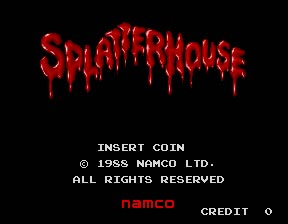 The title is a side-scrolling beat-em up – in the style of Final Fight, however control is limited to one plane of movement – left to right – the player cannot move up and down in the locations aside from jumping. Punching, kicking and sliding are the basic skills the player can call upon, however weapons such as meat cleavers and shotguns can also be acquired throughout the stages. Some levels are auto-scrolling, featuring the oft-hated screen edge catching up with you, which features in levels which have jumping, platforming elements. There was one inventive feature however – some levels feature branching gameplay. At the end of several rooms, you can choose to either go up or down a level in the mansion, which will result in the player experiencing a different set of rooms up until the end-of-level boss. The player would also be punished by falling down holes, but instead of losing a life, the player must complete an additional stage which would take place in the sewers, or basement – for example.
The title is a side-scrolling beat-em up – in the style of Final Fight, however control is limited to one plane of movement – left to right – the player cannot move up and down in the locations aside from jumping. Punching, kicking and sliding are the basic skills the player can call upon, however weapons such as meat cleavers and shotguns can also be acquired throughout the stages. Some levels are auto-scrolling, featuring the oft-hated screen edge catching up with you, which features in levels which have jumping, platforming elements. There was one inventive feature however – some levels feature branching gameplay. At the end of several rooms, you can choose to either go up or down a level in the mansion, which will result in the player experiencing a different set of rooms up until the end-of-level boss. The player would also be punished by falling down holes, but instead of losing a life, the player must complete an additional stage which would take place in the sewers, or basement – for example.
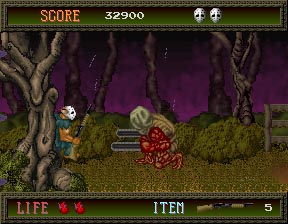 Boss battles are difficult, but varied. Each boss will attack in a different way and are relatively inventive in their design, so that there is little repetition from boss-to-boss. For example, the first level features a sea of mutant Leeches attacking you from both sides, which you must dodge and defeat and the third level sees you in a one-on-one battle with a chainsaw-wielding maniac, reminiscent of the sack-headed Majini in Resident Evil 5. The most creative one though is surely the level two antagonist, who is a Poltergeist. Upon finding yourself in an empty room, suddenly the candles start to fall from the ceiling, chairs fly about the room and knives take on a life of their own. You must defeat and dodge all of the possessed objects to defeat this spirit, and the idea of fighting it indirectly like this is very clever, and a departure from the standard boss battles often found in beat-em-ups.
Boss battles are difficult, but varied. Each boss will attack in a different way and are relatively inventive in their design, so that there is little repetition from boss-to-boss. For example, the first level features a sea of mutant Leeches attacking you from both sides, which you must dodge and defeat and the third level sees you in a one-on-one battle with a chainsaw-wielding maniac, reminiscent of the sack-headed Majini in Resident Evil 5. The most creative one though is surely the level two antagonist, who is a Poltergeist. Upon finding yourself in an empty room, suddenly the candles start to fall from the ceiling, chairs fly about the room and knives take on a life of their own. You must defeat and dodge all of the possessed objects to defeat this spirit, and the idea of fighting it indirectly like this is very clever, and a departure from the standard boss battles often found in beat-em-ups.
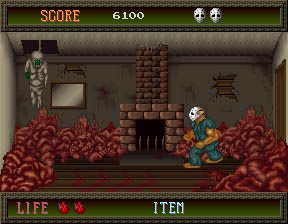 Splatterhouse remains one of the goriest games ever made – not just for its use of blood and violence, but the sick, twisted imagery used in creating some of the enemies. Many of your foes resemble intestines, the walls are lined with other internal bodily matter and when you kill one of these opponents, their belly may split open and spew dangerous bile onto the path in front of you, blocking your progress. Using weapons will often result in decapitations or maiming, coupled with splattering blood. The boss of stage six even resembles a womb, and destroying it unleashes a burst of embryonic fluid across the scene. This sort of graphic imagery was unheard of at the time, and kids in arcades loved it. When it came to home conversions however, most people ended up with the short straw. The Japanese PC-Engine version got away unscathed, but the Western TurboGrafx-16, PC and recent Wii Virtual Console release all suffer from a lot of censorship and content cut-down. Religious imagery is reduced or entirely removed, overall blood and gore is toned down and available weapons are less brutal (i.e. 2×4 instead of meat cleaver).
Splatterhouse remains one of the goriest games ever made – not just for its use of blood and violence, but the sick, twisted imagery used in creating some of the enemies. Many of your foes resemble intestines, the walls are lined with other internal bodily matter and when you kill one of these opponents, their belly may split open and spew dangerous bile onto the path in front of you, blocking your progress. Using weapons will often result in decapitations or maiming, coupled with splattering blood. The boss of stage six even resembles a womb, and destroying it unleashes a burst of embryonic fluid across the scene. This sort of graphic imagery was unheard of at the time, and kids in arcades loved it. When it came to home conversions however, most people ended up with the short straw. The Japanese PC-Engine version got away unscathed, but the Western TurboGrafx-16, PC and recent Wii Virtual Console release all suffer from a lot of censorship and content cut-down. Religious imagery is reduced or entirely removed, overall blood and gore is toned down and available weapons are less brutal (i.e. 2×4 instead of meat cleaver).
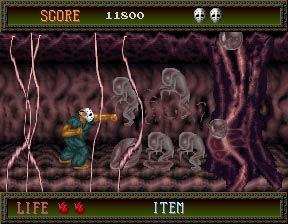 Sequels followed in 1992 and 1993, both on the SEGA Megadrive this time. The second game was much the same as the first in terms of gameplay, but tried to push the envelope further with gruesome graphics. The third game introduced three-dimensional movement throughout the levels, and maps were introduced as the game became less linear, featuring the option of finding secret rooms, and several different available endings. The third game was, however, the first game of the series to receive a “Mature” rating by the newly-formed Videogame rating Council – which was created after the hysteria and media frenzy around Mortal Kombat – Splatterhouse 3 never received a European release. It is a pity because the game is by far the best of the series, and the least offensive. It sacrificed the shock-value slightly for faster paced, timed levels – which encouraged exploration but rewarded timely completion. This new layer allowed the game to rise above being just a basic beat-em-up and was a good mechanic for keeping the player on the edge of their seat. Graphics and sound were also noticeably improved, with real actors used for between-level narratives.
Sequels followed in 1992 and 1993, both on the SEGA Megadrive this time. The second game was much the same as the first in terms of gameplay, but tried to push the envelope further with gruesome graphics. The third game introduced three-dimensional movement throughout the levels, and maps were introduced as the game became less linear, featuring the option of finding secret rooms, and several different available endings. The third game was, however, the first game of the series to receive a “Mature” rating by the newly-formed Videogame rating Council – which was created after the hysteria and media frenzy around Mortal Kombat – Splatterhouse 3 never received a European release. It is a pity because the game is by far the best of the series, and the least offensive. It sacrificed the shock-value slightly for faster paced, timed levels – which encouraged exploration but rewarded timely completion. This new layer allowed the game to rise above being just a basic beat-em-up and was a good mechanic for keeping the player on the edge of their seat. Graphics and sound were also noticeably improved, with real actors used for between-level narratives.
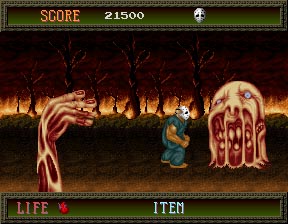 Held up to the standards of today, the games are very short, but even compared to other titles of the time, the first two Splatterhouse games can be cleared far too quickly. The gameplay is unoriginal and repetitive, but boss battles and the eerie atmosphere provide a spark which lifts the title above other Double Dragon clones in the genre. After that, Splatterhouse 3 took those elements and fashioned a more exciting game, with some modern ideas, to end the series on a high. Fans of Horror and gore will appreciate the subtle nods to movies, and the liberal spraying of claret, whilst those who love side-scrollers will find a solid, if not revolutionary, collection of games. A forgotten player in the history of mature gaming perhaps, but with a re-invention of the series freshly on the shelves, Rick is looking to make a comeback.
Held up to the standards of today, the games are very short, but even compared to other titles of the time, the first two Splatterhouse games can be cleared far too quickly. The gameplay is unoriginal and repetitive, but boss battles and the eerie atmosphere provide a spark which lifts the title above other Double Dragon clones in the genre. After that, Splatterhouse 3 took those elements and fashioned a more exciting game, with some modern ideas, to end the series on a high. Fans of Horror and gore will appreciate the subtle nods to movies, and the liberal spraying of claret, whilst those who love side-scrollers will find a solid, if not revolutionary, collection of games. A forgotten player in the history of mature gaming perhaps, but with a re-invention of the series freshly on the shelves, Rick is looking to make a comeback.
Namco Bandai Games released a re-imagining of the franchise for PlayStation 3 and Xbox 360 on November 26th. Look for a review shortly right here. The new game features playable versions of all three original Splatterhouse titles as unlockables. The God is a Geek Retro Corner will return the first Friday of every month.





